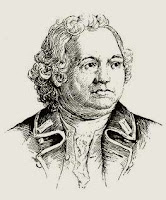When
Ezekiel Russell invited readers of the
Boston Censor to
order a collection of poems by
Phillis Wheatley in early 1772, she was already known in town as a poet.
Wheatley’s verses circulated in manuscript, and some had been printed. Her first published work was a 1766 poem on two sailors who had nearly been lost at sea, “On Messrs. Hussey and Coffin”; it appeared in the
Newport Mercury on 21 Dec 1767. A note in that
Rhode Island newspaper described her as “a Negro Girl (belonging to one Mr. Wheatley of Boston).” When Hussey and Coffin dined at John Wheatley’s house and “told of their narrow Escape, this Negro Girl at the same Time ’tending Table, heard the Relation, from which she composed the following Verses.”
In 1770, Wheatley wrote her poem on the death of the immensely popular Rev.
George Whitefield. Russell and
John Boyle published that on 11 October in two different forms in Boston—broadside and pamphlet. Those editions stated that the author was “PHILLIS, a Servant Girl of 17 Years of Age, belonging to Mr. J. WHEATLEY, of Boston.—And has been but 9 Years in this Country from Africa.” The printers went to the expense of advertising one form (which cost “7 Coppers”) in the
Boston News-Letter.
Boosted by Whitefield’s popularity, that poem was reissued by other Boston printers, and by printers in Newport,
New York, Philadelphia, and London. It was appended to the back of the Rev. Ebenezer Pemberton’s
sermon on Whitefield’s death, published in both Boston and London, with the name of “PHIILIS, a Negro Girl, of Seventeen Years of Age,” on the title page (as shown above).
The following year, a Boston woman named Jane Dunlap published a pamphlet titled
Poems Upon Several Sermons Preached by the Rev’d and Renowned George Whitefield While in Boston, She alluded to Wheatley’s reputation with these lines:
Shall his due praises be so loudly sung
By a young Afric damsels virgin tongue?
And I be silent!
In 1771, a broadside titled “To Mrs. Leonard, on the Death of her HUSBAND” was published with the credit “Phillis Wheatley” at the bottom. (This is a rare example of her being identified with a surname before she became free.) Her “On the Death of Doctor Samuel Marshall” appeared anonymously in the
Boston Evening-Post on 7 October. Some scholars suggests other poems in Boston newspapers, including one on the
Boston Massacre, were also Phillis Wheatley’s work.
Obviously, all those printers accepted that those poems were worthy of publication. Almost all gave Wheatley credit for them, highlighting rather than hiding her status as a young slave from Africa. Jane Dunlap acknowledged her as a poetic forerunner.
Furthermore, in nearly two centuries of research about Wheatley, no one has yet found any Bostonian expressing doubt that she composed her own verses. No one wrote to those newspapers pooh-poohing their credits—and Bostonians weren’t shy about arguing in the newspapers. No letters survive voicing skepticism about the Wheatley family’s outlandish claims about their slave girl.
I’m sure that some Bostonians were surprised at the notion of an enslaved teenager who had arrived in America only in 1761 being able to write poetry in the high style. It
was a remarkable achievement. But the only person we know put that surprise into writing was
Thomas Wooldridge, visiting from New York, and he was quickly convinced.
So where’s the evidence that Bostonians were “piqued” about Phillis Wheatley’s poetry?
TOMORROW:
Two readings of one letter.







